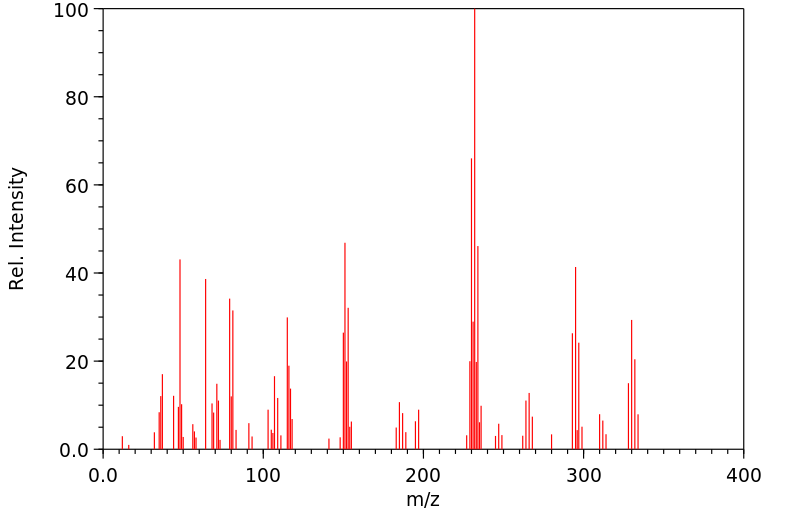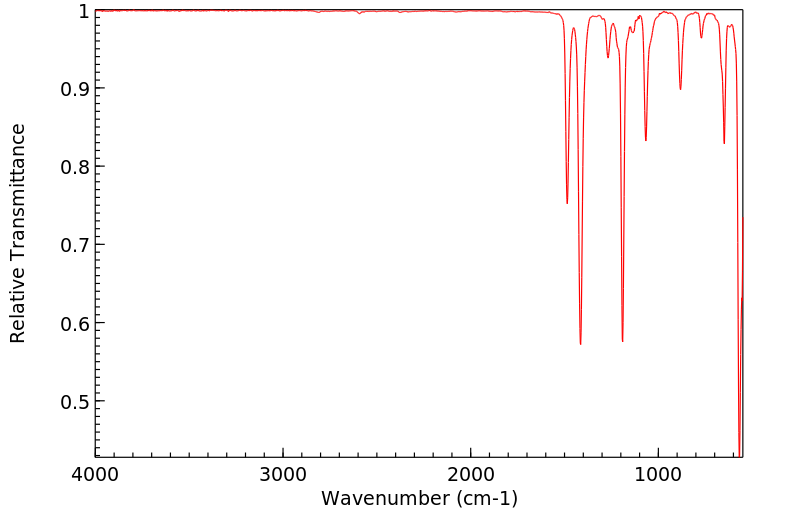4-溴-2,5-二氯噻酚-3-磺酰氯 | 166964-36-9
中文名称
4-溴-2,5-二氯噻酚-3-磺酰氯
中文别名
4-溴-2,5-二氯噻酚-3-磺酰氯;4-溴-2,5-二氯硫代苯-3-磺酰(基)氯;4-溴-2,5-二氯硫代苯-3-磺酰氯;4-溴-2,5-二氯噻吩-3-磺酰氯
英文名称
4-Bromo-2,5-dichloro-thiophene-3-sulfonyl chloride
英文别名
4-Bromo-2,5-dichlorothiophene-3-sulfonyl chloride
CAS
166964-36-9
化学式
C4BrCl3O2S2
mdl
MFCD00051664
分子量
330.438
InChiKey
NAHZODWKWDZKSZ-UHFFFAOYSA-N
BEILSTEIN
——
EINECS
——
-
物化性质
-
计算性质
-
ADMET
-
安全信息
-
SDS
-
制备方法与用途
-
上下游信息
-
文献信息
-
表征谱图
-
同类化合物
-
相关功能分类
-
相关结构分类
物化性质
-
熔点:70-72°C
-
沸点:119-121°C 1mm
-
闪点:119-121°C/1mm
-
稳定性/保质期:
避免与氧化物和水分接触。
计算性质
-
辛醇/水分配系数(LogP):4.2
-
重原子数:12
-
可旋转键数:1
-
环数:1.0
-
sp3杂化的碳原子比例:0.0
-
拓扑面积:70.8
-
氢给体数:0
-
氢受体数:3
安全信息
-
危险等级:8
-
危险品标志:C
-
安全说明:S8
-
危险类别码:R14
-
海关编码:2934999090
-
包装等级:II
-
危险品运输编号:UN 3094
-
储存条件:保存方法:密封于阴凉、通风干燥处。
SDS
| Name: | 4-Bromo-2 5-dichlorothiophene-3-sulfonyl chloride 97% Material Safety Data Sheet |
| Synonym: | |
| CAS: | 166964-36-9 |
Synonym:
Section 2 - COMPOSITION, INFORMATION ON INGREDIENTS
| CAS# | Chemical Name | content | EINECS# |
| 166964-36-9 | 4-Bromo-2,5-dichlorothiophene-3-sulfon | 97% | unlisted |
Risk Phrases: 34
Section 3 - HAZARDS IDENTIFICATION
EMERGENCY OVERVIEW
Causes burns.Moisture sensitive.
Potential Health Effects
Eye:
Causes eye burns.
Skin:
Causes skin burns.
Ingestion:
Causes gastrointestinal tract burns.
Inhalation:
Causes chemical burns to the respiratory tract.
Chronic:
Not available.
Section 4 - FIRST AID MEASURES
Eyes: Immediately flush eyes with plenty of water for at least 15 minutes, occasionally lifting the upper and lower eyelids. Get medical aid immediately.
Skin:
Get medical aid immediately. Immediately flush skin with plenty of water for at least 15 minutes while removing contaminated clothing and shoes.
Ingestion:
Do not induce vomiting. Get medical aid immediately.
Inhalation:
Get medical aid immediately. Remove from exposure and move to fresh air immediately. If not breathing, give artificial respiration. If breathing is difficult, give oxygen.
Notes to Physician:
Treat symptomatically and supportively.
Section 5 - FIRE FIGHTING MEASURES
General Information:
As in any fire, wear a self-contained breathing apparatus in pressure-demand, MSHA/NIOSH (approved or equivalent), and full protective gear.
Extinguishing Media:
Use foam, dry chemical, or carbon dioxide.
Section 6 - ACCIDENTAL RELEASE MEASURES
General Information: Use proper personal protective equipment as indicated in Section 8.
Spills/Leaks:
Vacuum or sweep up material and place into a suitable disposal container.
Section 7 - HANDLING and STORAGE
Handling:
Do not breathe dust, vapor, mist, or gas. Do not get in eyes, on skin, or on clothing. Use only in a chemical fume hood.
Storage:
Store in a cool, dry place. Store in a tightly closed container.
Corrosives area. Store under nitrogen.
Section 8 - EXPOSURE CONTROLS, PERSONAL PROTECTION
Engineering Controls:
Facilities storing or utilizing this material should be equipped with an eyewash facility and a safety shower. Use adequate ventilation to keep airborne concentrations low.
Exposure Limits CAS# 166964-36-9: Personal Protective Equipment Eyes: Not available.
Skin:
Wear appropriate protective gloves to prevent skin exposure.
Clothing:
Wear appropriate protective clothing to prevent skin exposure.
Respirators:
Follow the OSHA respirator regulations found in 29 CFR 1910.134 or European Standard EN 149. Use a NIOSH/MSHA or European Standard EN 149 approved respirator if exposure limits are exceeded or if irritation or other symptoms are experienced.
Section 9 - PHYSICAL AND CHEMICAL PROPERTIES
Physical State: Solid
Color: white
Odor: Not available.
pH: Not available.
Vapor Pressure: Not available.
Viscosity: Not available.
Boiling Point: 115 deg C @0.6mmHg
Freezing/Melting Point: 70 - 72 deg C
Autoignition Temperature: Not available.
Flash Point: Not available.
Explosion Limits, lower: Not available.
Explosion Limits, upper: Not available.
Decomposition Temperature:
Solubility in water:
Specific Gravity/Density:
Molecular Formula: C4BrCl3O2S2
Molecular Weight: 330
Section 10 - STABILITY AND REACTIVITY
Chemical Stability:
Not available.
Conditions to Avoid:
Incompatible materials, exposure to moist air or water.
Incompatibilities with Other Materials:
Strong oxidizing agents.
Hazardous Decomposition Products:
Hydrogen chloride, chlorine, carbon monoxide, oxides of sulfur, carbon dioxide, hydrogen bromide, bromine.
Hazardous Polymerization: Has not been reported
Section 11 - TOXICOLOGICAL INFORMATION
RTECS#:
CAS# 166964-36-9 unlisted.
LD50/LC50:
Not available.
Carcinogenicity:
4-Bromo-2,5-dichlorothiophene-3-sulfonyl chloride - Not listed by ACGIH, IARC, or NTP.
Section 12 - ECOLOGICAL INFORMATION
Section 13 - DISPOSAL CONSIDERATIONS
Dispose of in a manner consistent with federal, state, and local regulations.
Section 14 - TRANSPORT INFORMATION
IATA
Shipping Name: CORROSIVE SOLID, ACIDIC, ORGANIC, N.O.S.*
Hazard Class: 8
UN Number: 3261
Packing Group: III
IMO
Shipping Name: CORROSIVE SOLID, ACIDIC, ORGANIC, N.O.S.
Hazard Class: 8
UN Number: 3261
Packing Group: III
RID/ADR
Shipping Name: CORROSIVE SOLID, ACIDIC, ORGANIC, N.O.S.
Hazard Class: 8
UN Number: 3261
Packing group: III
Section 15 - REGULATORY INFORMATION
European/International Regulations
European Labeling in Accordance with EC Directives
Hazard Symbols: C
Risk Phrases:
R 34 Causes burns.
Safety Phrases:
S 26 In case of contact with eyes, rinse immediately
with plenty of water and seek medical advice.
S 36/37/39 Wear suitable protective clothing, gloves
and eye/face protection.
S 45 In case of accident or if you feel unwell, seek
medical advice immediately (show the label where
possible).
WGK (Water Danger/Protection)
CAS# 166964-36-9: No information available.
Canada
None of the chemicals in this product are listed on the DSL/NDSL list.
CAS# 166964-36-9 is not listed on Canada's Ingredient Disclosure List.
US FEDERAL
TSCA
CAS# 166964-36-9 is not listed on the TSCA inventory.
It is for research and development use only.
SECTION 16 - ADDITIONAL INFORMATION
N/A
上下游信息
-
下游产品
中文名称 英文名称 CAS号 化学式 分子量 —— 4-bromo-2,5-dichloro-thiophene-3-sulfonamide 256525-69-6 C4H2BrCl2NO2S2 311.007
反应信息
-
作为反应物:描述:4-溴-2,5-二氯噻酚-3-磺酰氯 在 ammonium hydroxide 、 乙酸乙酯 作用下, 反应 16.0h, 生成 4-bromo-2,5-dichloro-thiophene-3-sulfonamide参考文献:名称:N-Acyl arylsulfonamides as novel, reversible inhibitors of human steroid sulfatase摘要:Steroid sulfatase (STS) is an attractive target for a range of oestrogen- and androgen-dependent diseases. In search of novel chemotypes of STS inhibitors, we had previously identified nortropinyl-arylsulfonylureas 1; however, while these compounds were good inhibitors of purified STS (lowest K-i = 76 nM), they showed only weak inhibition of STS activity in cells (lowest IC50 around 2 muM). Extended structure-activity relationship studies involving modification of the phenylacetyl side chain and replacement of the nortropine element by simpler scaffolds led to the discovery of N-acyl arylsulfonamides, more specifically N-(Boc-piperidine-4-carbonyl)-benzenesulfonamides, as STS inhibitors, some of which exhibit improved cellular potency (best IC50 = 270 nM). (C) 2004 Elsevier Ltd. All rights reserved.DOI:10.1016/j.bmcl.2004.11.069
文献信息
-
Biphenylsulfonamides and derivatives thereof that modulate the activity of endothelin申请人:——公开号:US20020095041A1公开(公告)日:2002-07-18Biphenylsulfonamides and methods for modulating or altering the activity of the endothelin family of peptides are provided. In particular, bicyclic or tricyclic carbon or heterocyclic ring biphenylsulfonamides and methods using these sulfonamides for inhibiting the binding of an endothelin peptide to an endothelin receptor by contacting the receptor with the sulfonamide are provided. Methods for treating endothelin-mediated disorders by administering effective amounts of one or more of these sulfonamides or prodrugs thereof that inhibit or increase the activity of endothelin are also provided.
-
Tyrosine alkoxyguanidines as integrin inhibitors申请人:3-Dimensional Pharmaceuticals, Inc.公开号:US06344484B1公开(公告)日:2002-02-05The present invention relates to novel tyrosine alkoxyguanidine compounds that are inhibitors of alpha V (&agr;v) integrins, for example &agr;v&bgr;3 and &agr;v&bgr;5 integrins, their pharmaceutically acceptable salts, and pharmaceutical compositions thereof. The compounds may be used in the treatment of pathological conditions mediated by &agr;v&bgr;3 and &agr;v&bgr;5 integrins, including conditions such as tumor growth, metastasis, restenosis, osteoporosis, inflammation, macular degeneration, diabetic retinopathy, and rheumatoid arthritis. The compounds have the general formula: where R1, R2, R3, R4, R5, R6, R7, R8, R9, R10, R11, m and n are defined herein.
-
N-aryl thienyl-, furyl-, and pyrrolyl-sulfonamides and derivatives thereof that modulate the activity of endothelin申请人:Texas Biotechnology Corp.公开号:US06342610B2公开(公告)日:2002-01-29Thienyl-, furyl- and pyrrolyl-sulfonamides and methods for modulating or altering the activity of the endothelin family of peptides are provided. In particular, N-(isoxazolyl)thienylsulfonamides, N-(isoxazolyl)furylsulfonamides and N-(isoxazolyl)pyrrolylsulfonamides and methods using these sulfonamides for inhibiting the binding of an endothelin peptide to an endothelin receptor by contacting the receptor with the sulfonamide are provided. Methods for treating endothelin-mediated disorders by administering effective amounts of one or more of these sulfonamides or prodrugs thereof that inhibit or increase the activity of endothelin are also provided.
-
Palladium-catalyzed direct desulfitative C2 arylations of 3-halo-N-protected indoles using (hetero)arenesulfonyl chlorides作者:Anoir Hfaiedh、Hamed Ben Ammar、Jean-François Soulé、Henri DoucetDOI:10.1039/c6ob00584e日期:——through a direct desulfitative arylation, followed by in situ dehalogenation. While, from 3-bromoindole derivatives, 2-aryl-3-bromoindoles were obtained without debromination, and could be converted into 2,3-diarylindoles through a second palladium coupling. This method allows one to prepare in a few steps a very wide variety of indole derivatives, which are of interest in the synthesis of bioactive molecules
-
A Sulfonamide Sialoside Analogue for Targeting Siglec-8 and -F on Immune Cells作者:Corwin M. Nycholat、Shiteng Duan、Eva Knuplez、Charli Worth、Mila Elich、Anzhi Yao、Jeremy O’Sullivan、Ryan McBride、Yadong Wei、Steve M. Fernandes、Zhou Zhu、Ronald L. Schnaar、Bruce S. Bochner、James C. PaulsonDOI:10.1021/jacs.9b05769日期:2019.9.11im-munoglobulin-like cell surface receptors have emerged as attractive targets for cell directed therapies due to their restricted expression on immune cells, endocytic properties and ability to modulate receptor signaling. Human Siglec-8, for instance has been identified as a therapeutic target for the treatment of eosinophil and mast cell disorders. A promising strategy to target Sig-lecs involves theSiglec 家族的唾液酸结合免疫球蛋白样细胞表面受体已成为细胞定向治疗的有吸引力的靶点,因为它们在免疫细胞上的表达受限、内吞特性和调节受体信号的能力。例如,人类 Siglec-8 已被确定为治疗嗜酸性粒细胞和肥大细胞疾病的治疗靶点。靶向 Sig-lecs 的一个有前景的策略涉及使用具有多价展示 Siglec 配体的脂质体纳米颗粒。这种方法的一个关键挑战是识别目标 Siglec 的高亲和力配体。在这里,我们报告了 Siglec-8 的高亲和力配体及其最接近的鼠功能直向同源物 Siglec-F 的开发,它能够将脂质体靶向表达 Siglec-8 或 -F 的细胞。筛选了 156 个合成的 9-N-磺酰基唾液酸类似物的聚糖微阵列库,以识别潜在的先导化合物。最佳配体,9-N-(2-萘基磺酰基)-Neu5Acα2-3-[6-O-磺基]-Galβ1-4GlcNAc(6'-O-磺基NSANeu5Ac)结
表征谱图
-
氢谱1HNMR
-
质谱MS
-
碳谱13CNMR
-
红外IR
-
拉曼Raman
-
峰位数据
-
峰位匹配
-
表征信息
同类化合物
试剂2,5-Dibromo-3,4-dihexylthiophene
苯-1,2,4-三羧酸-丙烷-1,2,3-三醇(1:1)
碘吡咯
癸氯-二茂铁
甲酮,(4,5-二溴-1H-吡咯-2-基)苯基-
甲基3-氟-1H-1,2,4-三唑-5-羧酸酯
溴代二茂铁
溴-(3-溴-2-噻嗯基)镁
派瑞林D
派瑞林 F 二聚体
氯代二茂铁
曲洛酯
异噻唑,3-氯-5-甲基-
地茂酮
四碘硒吩
四碘噻吩
四碘呋喃
四溴噻吩
四溴吡咯
四溴-N-甲基吡咯
四氯噻吩
四氟噻吩
噻菌腈
噻美尼定.
噻吩,3-溴-4-(1-辛炔基)-
噻吩,3-溴-2-[2-(甲硫基)乙烯基]-,(Z)-
噻吩,3-溴-2-[2-(甲硫基)乙烯基]-,(E)-
噻吩,3-溴-2-[2-(甲硫基)乙烯基]-,(E)-
噻吩,2,5-二氯-3,4-二(氯甲基)-
喷贝特
咪唑烷,2-(4-溴-5-甲基-2-呋喃基)-1,3-二甲基-
叔丁基2-溴-4,6-二氢-5H-吡咯并[3,4-D]噻唑-5-羧酸酯
叔-丁基3-溴-6,7-二氢-1H-吡唑并[4,3-C]吡啶-5(4H)-甲酸基酯
叔-丁基2-溴-5,6-二氢咪唑并[1,2-A]吡嗪-7(8H)-甲酸基酯
叔-丁基(4-溴-5-氰基-1-甲基-1H-吡唑-3-基)氨基甲酯
双环[4.2.0]辛-1,3,5-三烯-7-甲腈,2-氟-
八氟联苯烯
八氟二苯并硒吩
全氟苯并环丁烯二酮
二苯基氯化碘盐
二联苯碘硫酸盐
二氯对二甲苯二聚体
二氯[2-甲基-3(2H)-异噻唑酮-O]的钙合物
二氯-1,2-二硫环戊烯酮
二-(3-溴-1,2,4-噻二唑-5-基)-二硫醚
二(2-噻吩基)碘鎓
乙酸,[[[1-(3-溴-5-异[口噁]唑基)亚乙基]氨基]氧代]-,甲基酯,(E)-
[四丁基铵][Δ-三(四氯-1,2-苯二醇酸根)磷酸盐(V)]
[3-(4-氯-3,5-二甲基-1H-吡唑-1-基)丙基]胺
[3-(4-氯-1H-吡唑-1-基)-2-甲基丙基]胺








